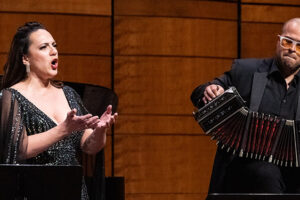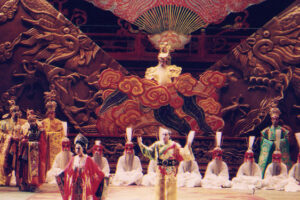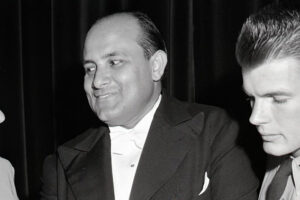

The revised Appomattox reflects substantial changes from the original 2007 incarnation in San Francisco, taking into account material that librettist Hampton subsequently developed for a non-musical staging seen at Minneapolis’ Guthrie Theater in 2012. After the first act, which follows the closing weeks of the Civil War leading up to Lee’s surrender, we now have an expanded second Act, devoted to events of the Civil Rights movement in 1965 and after. These revisions, Glass and Hampton have said, are motivated by recent assaults on voting rights protections, and the Supreme Court’s controversial overturning of a critical section of the Voting Rights Act.
Laudable goals, to be sure! Unfortunately, the piece as presented Saturday night fails to deliver much in the way of compelling theater or thoughtful insights about its subject matter. The libretto is the real culprit here, a casualty of the belief that the normal components of drama, historical or otherwise, aren’t needed as long as you have epic sweep, historical gravitas, lot of characters, and lots of scenes. Appomattox is all exposition about historical conflict without any actual conflict, pageantry in place of the kind of drama capable of truly moving and enlightening an audience.
The first act dutifully trudges through all the greatest hits of the war’s closing days. If the History Channel dispensed with its nonfiction pretensions and just started churning out feature length versions of its hoariest dramatizations, it might look something like this. Over and over again, the heavy-handed text reaches for the on-the-nose option to convey familiar points.
See, for example, an attempt to balance a rosy portrait of Lincoln (Tom Fox) by having Mary Todd (Anne Carolyn Bird) ask where women, including black women, fall in his plans for expanding suffrage. His response, something to the effect of “don’t go getting too crazy now,” plays as a punchline, eliciting a dreadful round of guffaws from the audience. A few moments allow the story to breathe a bit, like a short digression for Ulysses S. Grant’s wife Julia, on the Grants’ hardscrabble background, movingly tackled by Melody Moore’s formidable, incisive soprano, but these are few and far between.
More troubling are the tired tropes about Robert E. Lee (David Pittsinger) and his noble leadership of a terrible cause, a key ingredient in the “civilized” tone of the surrender at Appomattox which Glass and Hampton cite as the thing that initially drew them to the material. I will refrain from going any further down this rabbit hole, but let’s just say that sympathy-mongering for Robert E. Lee sits rather uncomfortably in a story now dedicated to the struggle for equality and civil rights.
The second half, set in 1965, starts off strong, with a lyrical scene of Martin Luther King speaking at Jimmie Lee Jackson’s funeral in advance of the march to Montgomery. Sung beautifully here by bass Solomon Howard, who will sing Fafner in Siegfried in the spring, this is the first of two set pieces for King and the chorus that are among the highlights of the second act. But the bulk of the act rambles on with civil rights era trivia, devoting most of its stage time to the profane, irascible antics of Lyndon Johnson (Fox) in a series of meetings with King, attorney general Nicholas Katzenbach, George Wallace and J. Edgar Hoover. In a straight play, the endless crassness of the Johnson character probably would make for some satisfying scenery chewing. In an opera, where a singer’s ability to realize a killer LBJ impersonation is limited, it is mostly tedious.
Finally, we fast forward again, to an invented 2011 meeting between Edgar Ray Killen, Klan member and murderer of three civil rights activists who was convicted years later in 2005, and the state trooper who served only nominal time for Jimmie Lee Jackson’s killing. The scene is harrowing for its gruesome depiction of Killen’s crime, sung with menacing power by Pittsinger, and effectively set to jarring percussion-heavy figures in the score.
But what are we supposed to take from this one-off scene? Comfort in our moral superiority over smug unrepentant murderous white supremacists? A final chorus exhorting the audience to “bury your prejudice with Jimmie Lee” and some closing treacle about “reaching our destiny” is indicative of just how few ideas the libretto has to offer.
With such a problematic piece, it’s hard to know where to start with the score. Glass’s music has certainly proven effective in the service of both traditional drama (see his 1993 opera Orphee, beautifully presented here a few years ago by Virginia Opera) as well as better known experimental fare like Satyagraha or Einstein on the Beach, but this is a different challenge. Appomattox isn’t contemplative or abstract, it is thuddingly literal. Yet few of the characters have anything resembling an interior life that might be illuminated through the score; most just declaim their Wikipedia pages.
Neither does the libretto strive to create tension or momentum that the music can latch onto. The choral set pieces—Abraham Lincoln’s arrival in Richmond, the opening Act II funeral, and a setting of “Battle Hymn of the Republic” led by MLK (in lieu of the prohibited text of his actual speeches)—make the biggest impression, but these sections ultimately feel isolated.
WNO deserves credit for doing its best to put the work on a solid footing. Additional highlights of the large and impressive cast include tenor Frederick Ballentine, who offers a memorable turn as journalist T. Morris Chester, especially in his monologue closing the first act. Conductor Dante Santiago Anzolini, stepping in only recently for the originally scheduled Dennis Russell Davies, handles the intricate rhythmic and dynamic turns of the score well.
On the production end, Tazewell Thompson’s direction nicely manages the swirling action and pulls off a number of striking moments, including the large tattered Confederate battle flag that falls to the ground to before a chorus from of black Union soldiers. A simple and effective set design, by Donald Eastman, places the action on an immaculate white colonnade and balcony suggesting a 19th century courthouse, and delivers both a sense of modest gravity and a versatile playing space. Lighting design by Robert Wierzel keeps the static set interesting, deploying evocative warm natural lighting when the space played office or church as well as more dramatic effects.
Photo by Scott Suchman
























Comments